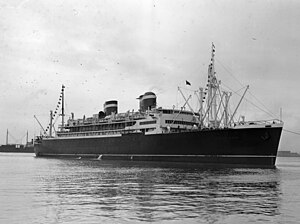 SS Santa Rosa in Grace Line livery, 1932
| |
| History | |
|---|---|
| Name | SS Santa Rosa |
| Operator | Grace Line (1932–41, 1947–58) |
| Port of registry | San Francisco, California |
| Route | New York - Havana - Cristobal - the Panama Canal - Balboa - Puntarenas - La Libertad - San Jose de Guatemala - Mazatlan - Los Angeles - San Francisco - Victoria - Seattle. |
| Ordered | 1930 |
| Builder | Federal Shipbuilding and Drydock Company |
| Yard number | 121 |
| Laid down | 22 June 1931 |
| Launched | 24 March 1932 |
| Completed | Delivered: 27 October 1932 |
| Maiden voyage | 26 November 1932 |
| Out of service | 1958 |
| Identification |
|
| Fate | Sold in 1961 |
| Name | Santa Rosa |
| Operator | War Shipping Administration (1942–47) |
| Port of registry | New York |
| Name | SS Athinai |
| Operator | Aegean Steam Navigation Co (Typaldos Line) |
| Acquired | 1961 |
| In service | 1961 |
| Out of service | 1966 |
| Homeport | Piraeus, Greece |
| Identification | IMO number: 5028631 |
| Fate | Scrapped 1989, Aliaga, Izmir-Turkey |
| General characteristics [1][2][3] | |
| Tonnage | 9,135 GRT, 3,839 NRT |
| Displacement | Commercial 16,500 tons |
| Length |
|
| Beam | 72.2 ft (22.0 m) |
| Draft | 26 ft 2.5 in (8.0 m) |
| Depth |
|
| Installed power | 4 × Babcock & Wilcox boilers furnishing steam for main engines & auxiliaries. 2 × 500 kw DC generators 1 on each main engine low pressure side, 2 × 500 kw standby generating sets |
| Propulsion | 2 × General Electric double reduction gear steam turbines, 6,000 shp normal, 6,600 shp max (propeller speeds 95/98 rpm), |
| Speed | |
| Capacity |
|
| Crew | 180 (registry, commercial) |
| Notes | |
SS Santa Rosa (later SS Athinai) was a passenger and cargo ocean liner built for the Grace Line for operation by its subsidiary Panama Mail Steamship Company of San Francisco. She was the first to be launched and operating of four sister ships, the others in order of launch being Santa Paula (11 June 1932), Santa Lucia (3 October 1932) and Santa Elena (30 November 1932). All four ships, dubbed "The Four Sisters" and "The Big Four" were noted as the finest serving the West Coast and were of advanced technology. All served in World War II as War Shipping Administration (WSA) troop ships. Both Santa Lucia and Santa Elena were lost in air and torpedo attacks off North Africa.
The ship was ordered in 1930 from the Federal Shipbuilding and Drydock Company of Kearny, New Jersey. Her regular route included inter-coastal service between the east coast and the west coast of the US via the Caribbean and the Panama Canal. She was the second of ultimately three vessels to bear the name Santa Rosa for the Grace Line.[4] (The first Santa Rosa was a 1917-built ship that was sold in 1925.)[5]
- ^ Pacific American Steamship Association; Shipowners Association of the Pacific Coast (December 1932). "Four New Grace Liners". Pacific Marine Review. San Francisco: J.S. Hines: 435–436. Retrieved 11 June 2021.
- ^ Pacific American Steamship Association; Shipowners Association of the Pacific Coast (December 1932). "Power Plants of Grace Liners". Pacific Marine Review. San Francisco: J.S. Hines: 443–449. Retrieved 11 June 2021.
- ^ Merchant Vessels of the United States,Year ended June 30, 1934. Washington, D.C.: Department of Commerce, Bureau of Navigation and Steamboat Inspection. 1934. pp. 156–157. hdl:2027/osu.32435066706961. Retrieved 13 June 2021.
- ^ "Grace Line Fleet 1882-1969". TheShipsList.com. Archived from the original on 17 February 2012. Retrieved 20 January 2012.
- ^ "Santa Rosa (1917)". MaritimeQuest.com. Retrieved 20 January 2012.